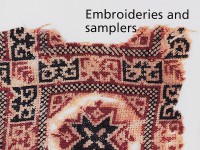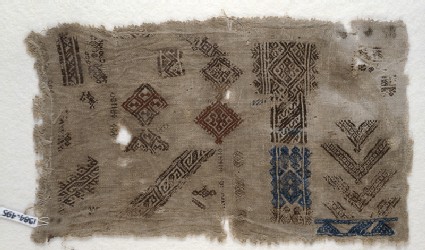Embroideries and Samplers from Islamic Egypt
A selection of 10th to 16th century embroideries from the Newberry collection at the Ashmolean by Marianne Ellis (published Oxford, 2001).

Publications online: 66 objects
- Reference URL
Actions
Sampler fragment with diamond-shapes and chevrons
-
Literature notes
The patterns on this sampler are found on clothing. The V-shapes (lower right) show how to work a pattern at the bottom of a neck slit opening. From this an embroidered medallion was sometimes suspended, and this sampler provides two examples of diamond-shapes with tiny hooks along the edges for an embroiderer to copy. The two diagonal bands with S- and Z-shapes repeated along their length (lower left) are models for diagonal stripes; the Newberry collection contains two fragments of trouser cuffs worked with comparable ones. The blue straight narrow band (lower right) is typical of those found on tunics; two design elements alternate to form a pattern enclosed by parallel lines of stitching. Sometimes similar parallel lines enclose panels of decoration as seen on a child 's tunic, illustration No. 17 [EA1984.353]. The word "Fustat" and the date 14.7.('32) are written on the back of the embroidery so this is presumably where and when Professor Newberry acquired it. His wife wrote that many items were added to the collection in the 1930s from rubbish heaps in the area of Fustat, in the southern quarter of present day Cairo. -
Details
- Associated place
-
Near East (place of creation)
- Date
-
13th century (1201 - 1300)
Ayyubid Period (1169 - 1260)
Mamluk Period (1250 - 1517)
- Material and technique
- linen, embroidered with brown, red, and blue silk; with stitching in flax
- Dimensions
-
27.5 x 16.5 cm (length x width)
along length/width 15 / 19 threads/cm (thread count)
ground fabric 0.05 cm (thread diameter)
additional fibre, embroidery 0.05 cm (thread diameter)
- Material index
-
organic › animal › animal product › silk,
- Technique index
-
assembled › woven › plain woven,woven › plain woven,
- Object type index
- No. of items
- 1
- Credit line
- Presented by Professor Percy Newberry, 1941.
- Accession no.
- EA1984.495
-
Further reading
Ellis, Marianne, Embroideries and Samplers from Islamic Egypt (Oxford: Ashmolean Museum, in association with Greenville: Curious Works Press, 2001), no. 13 on p. 26, pp. 8 & 35, illus. p. 26
Barnes, Ruth and Marianne Ellis, ‘The Newberry Collection of Islamic Embroideries’, 4 vols, 2001, Oxford, Ashmolean Museum, cat. vol. iii, illus. vol. i
Location
-
- currently in research collection
Objects are sometimes moved to a different location. Our object location data is usually updated on a monthly basis. Contact the Jameel Study Centre if you are planning to visit the museum to see a particular object on display, or would like to arrange an appointment to see an object in our reserve collections.
Galleries
Publications online
-

Embroideries and Samplers from Islamic Egypt
The patterns on this sampler are found on clothing. The V-shapes (lower right) show how to work a pattern at the bottom of a neck slit opening. From this an embroidered medallion was sometimes suspended, and this sampler provides two examples of diamond-shapes with tiny hooks along the edges for an embroiderer to copy. The two diagonal bands with S- and Z-shapes repeated along their length (lower left) are models for diagonal stripes; the Newberry collection contains two fragments of trouser cuffs worked with comparable ones. The blue straight narrow band (lower right) is typical of those found on tunics; two design elements alternate to form a pattern enclosed by parallel lines of stitching. Sometimes similar parallel lines enclose panels of decoration as seen on a child 's tunic, illustration No. 17 [EA1984.353]. The word "Fustat" and the date 14.7.('32) are written on the back of the embroidery so this is presumably where and when Professor Newberry acquired it. His wife wrote that many items were added to the collection in the 1930s from rubbish heaps in the area of Fustat, in the southern quarter of present day Cairo. -

The Newberry Collection of Islamic Embroideries
A sampler fragment with rectangles, bands, and diamonds, as well as chevrons, all filled with hook motifs, S-shapes, or small diamonds.
The sampler has been radiocarbon dated to 1281 AD +/- 35.
Notice
Object information may not accurately reflect the actual contents of the original publication, since our online objects contain current information held in our collections database. Click on 'buy this publication' to purchase printed versions of our online publications, where available, or contact the Jameel Study Centre to arrange access to books on our collections that are now out of print.
© 2013 University of Oxford - Ashmolean Museum


